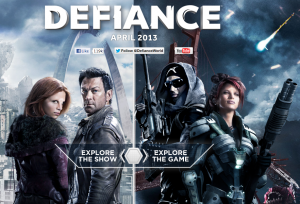One World, Two Ways In (For Some): Syfy’s Defiance
 When Syfy president Dave Howe introduced Defiance’s at the TCA Press Tour in January, he referred to the project as “a groundbreaking transmedia event that unites high quality scripted television and online gaming in an unprecedented way. In short, Defiance is one world, but with two ways in.” While my previous post on Defiance considered the ways in which the respective futures of the video game and the television series could follow different paths, here I want to focus on who Syfy and developer Trion Worlds expect to travel through the respective entrances to the world in question.
When Syfy president Dave Howe introduced Defiance’s at the TCA Press Tour in January, he referred to the project as “a groundbreaking transmedia event that unites high quality scripted television and online gaming in an unprecedented way. In short, Defiance is one world, but with two ways in.” While my previous post on Defiance considered the ways in which the respective futures of the video game and the television series could follow different paths, here I want to focus on who Syfy and developer Trion Worlds expect to travel through the respective entrances to the world in question.
While Henry Jenkins and others have rightfully observed the potential for innovative storytelling and expanded audience engagement through convergent media practices, transmedia storytelling also functions as a solution to a problem. Howe positions Defiance as the result after Syfy “imagined the future of entertainment as technology evolves across new digital screens and platforms,” but fails to acknowledge that this was not simply the result of innovative thinking but rather data suggesting Syfy and channels like it were losing viewers to other forms of media, including video games. The commercial imperatives behind convergence may not appear in public relations copy, but cross-platform projects like Defiance are about reaching certain audiences productive to Syfy’s long-term programming and branding goals in a convergent media environment
To be clear, this does not necessarily devalue the creative potential of Defiance as a transmedia storytelling experience (this DICE keynote features some intriguing production culture details), but I choose to foreground commercial imperatives due to incongruence between the audiences these projects seek to draw. While Howe is correct that there are two entrances into this world, those entrances are functioning within two industries where audience targeting works differently, and the gaming doorway is considerably narrower—and more male-oriented—than the television one.
 In the case of Syfy, Defiance is positioned within a broader tradition of science fiction on the channel, including Battlestar Galactica and Farscape. One could look to the frontier setting and the presence of a brothel as evidence of the series appealing to male audiences, but Defiance mirrors Galactica’s focus on women in power (Julie Benz’s Amanda Rosewater is the town’s mayor) and follows NBC’s Revolution into the realm of young, tough female characters (Stephanie Leonidas’ Irisa). While the series contains elements we could deconstruct as being aimed toward male audiences, it ultimately seeks a balanced approach designed to maximize viewership within fans of science fiction programming (already a niche that is dangerous to narrow further, as demonstrated by Syfy’s efforts to extend their brand away from high science fiction toward lighter genre fare).
In the case of Syfy, Defiance is positioned within a broader tradition of science fiction on the channel, including Battlestar Galactica and Farscape. One could look to the frontier setting and the presence of a brothel as evidence of the series appealing to male audiences, but Defiance mirrors Galactica’s focus on women in power (Julie Benz’s Amanda Rosewater is the town’s mayor) and follows NBC’s Revolution into the realm of young, tough female characters (Stephanie Leonidas’ Irisa). While the series contains elements we could deconstruct as being aimed toward male audiences, it ultimately seeks a balanced approach designed to maximize viewership within fans of science fiction programming (already a niche that is dangerous to narrow further, as demonstrated by Syfy’s efforts to extend their brand away from high science fiction toward lighter genre fare).
However, when I asked a Trion Worlds developer about the target audience for the video game, his answer was simpler: “Shooter fans.” The game’s claim to notoriety is not simply its transmedia relationship with the television series, but also its combination of Massively Multiplayer Online gameplay and third-person shooter mechanics similar to series like Gears of War. In this, the game seeks to merge the MMO model with what stands as the largest gaming audience on home game consoles, the audience that has made series like Gears of War or Call of Duty so successful. This is also an audience that is almost exclusively imagined as male by those within the gaming industry.
 Of course, female gamers are among those who have made the shooter genre so successful—I spoke with one female critic who identified as a shooter fan as we discussed playing Defiance at TCA—but they are not the audience being sold to when a company like Trion Worlds develops a game like Defiance. Although there is plenty of evidence to suggest that women make up a large percentage—up to 60%—of those who play video games, industry logic suggests that gameplay takes place within more casual gaming spaces, which could include web browsers, mobile devices devices, or home consoles like the Wii which came to be known for their cross-gender and cross-generational appeal. While Massively Multiplayer Role-Playing Games (MMORPGs) are considered a space where women make up a substantial portion of active players, Trion’s decision to focus on third-person shooting pushes Defiance’s demographics toward an imagined collection of male core gamers age 18-34 considered more likely to own the consoles or gaming hardware necessary to take part in this experience, a demographic often referred to as the “lost boys.”
Of course, female gamers are among those who have made the shooter genre so successful—I spoke with one female critic who identified as a shooter fan as we discussed playing Defiance at TCA—but they are not the audience being sold to when a company like Trion Worlds develops a game like Defiance. Although there is plenty of evidence to suggest that women make up a large percentage—up to 60%—of those who play video games, industry logic suggests that gameplay takes place within more casual gaming spaces, which could include web browsers, mobile devices devices, or home consoles like the Wii which came to be known for their cross-gender and cross-generational appeal. While Massively Multiplayer Role-Playing Games (MMORPGs) are considered a space where women make up a substantial portion of active players, Trion’s decision to focus on third-person shooting pushes Defiance’s demographics toward an imagined collection of male core gamers age 18-34 considered more likely to own the consoles or gaming hardware necessary to take part in this experience, a demographic often referred to as the “lost boys.”
Trion’s development choice creates an imbalance between the two entrances Bell refers to: while fans of the game can easily transition their attention to a television series (something they could even watch on their game console or PC), the choice to emphasize core gamer mechanics rather than a more accessible gameplay style limits the likelihood of viewers—both female and male—with only casual gaming experience accessing the complete Defiance experience.[1] While Defiance the television series may seek to expand its focus beyond a primarily male audience, Defiance as a broader—yet narrower—transmedia initiative highlights the gendered reality of convergent media practices tied to the video game industry’s male-dominated logics.
Trion and Syfy’s decision to focus on hardcore gamers does not preclude female gamers from experiencing Defiance as a transmedia narrative, but their adherence to game industry logics—most likely to manage financial risk in a big-budget console video game space—shapes their imagined user as a “lost boy” Syfy seeks to find. Although the show could enable Syfy to embrace this young male demographic—which sister channel G4 recently gave up on—should the game be successful, it also confines the transmedia narrative to a gendered understanding of convergence that imagines gaming as a lure for male viewers rather than a creative extension for all viewers.
[1] The Trion developers overseeing Syfy’s TCA event admitted the difficulty setting was set very high on the demo made available (which had been made for a gaming industry event months earlier), to the point where more casual players—including several Syfy executives and stars—who tried it were often frustrated by a lack of progress.


